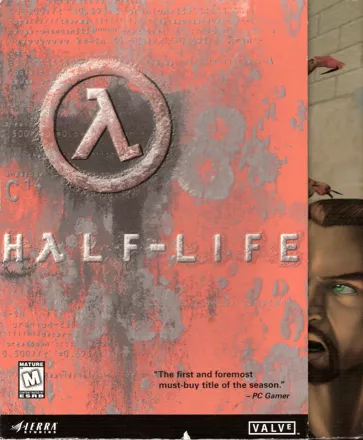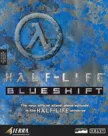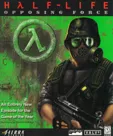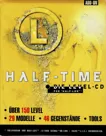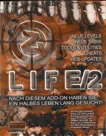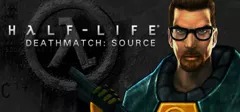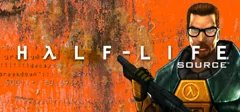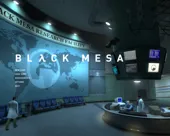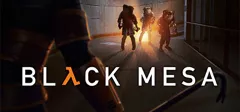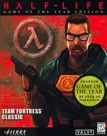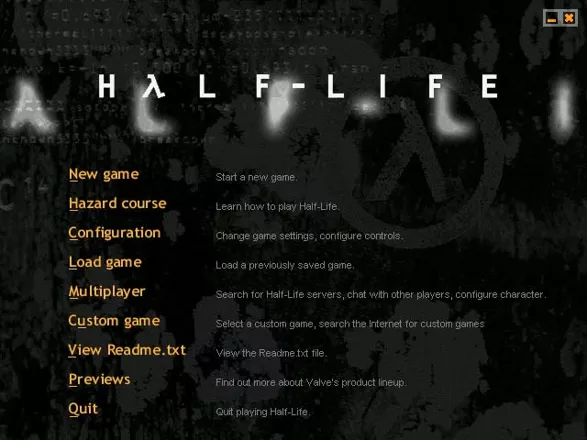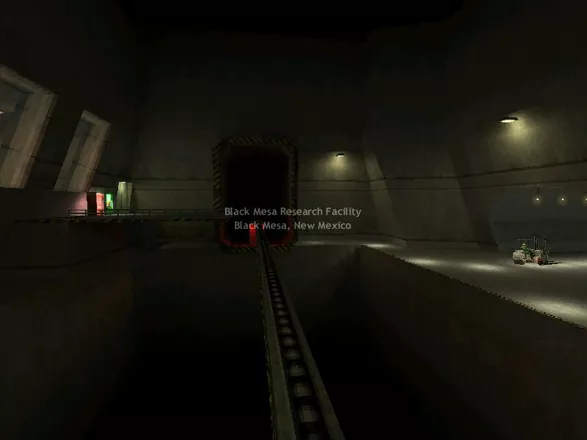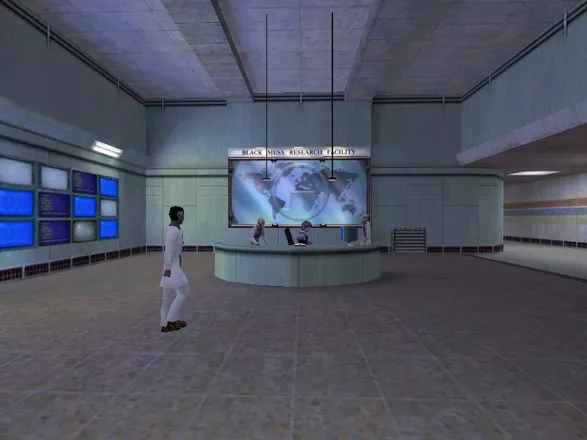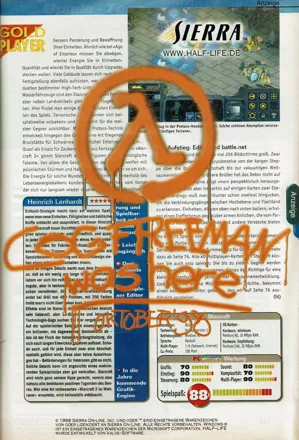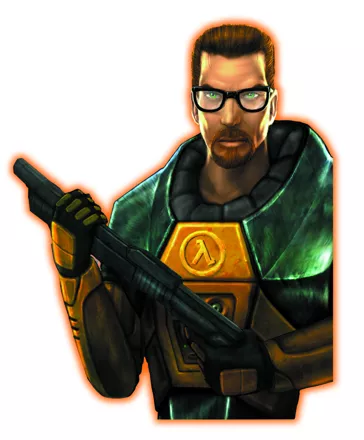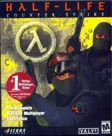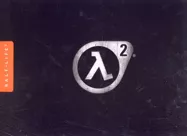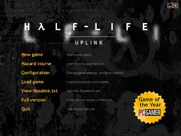Half-Life
-
 Half-Life
(2001 on
PlayStation 2)
Half-Life
(2001 on
PlayStation 2)
Description official descriptions
The Black Mesa Research Facility is an ultra-secret laboratory under a government contract to conduct top-secret and extremely volatile experiments. The scientist Gordon Freeman is a Black Mesa employee. One morning, as usual, he pits his way to the research facility for a run-of-the-mill experiment. However, Gordon comes to realize that it might not be as ordinary as he thought. Odd things happen as he makes his way to one of the Black Mesa test chambers. Even stranger things happen when he begins to move the test sample towards the anti-mass spectrometer.
At that moment, everything goes horribly wrong. Aliens from the dimension Xen suddenly invade the facility, injuring or killing many of the employees. Soon afterwards, marines arrive to contain the situation by killing the aliens as well as the surviving human witnesses. Gordon understands what that means: he will have to fight his way through both aliens and marines to get to the top of the Black Mesa complex and to freedom.
The story of Half-Life is told entirely in-game: everything is seen through the eyes of the protagonist. Most story elements unfold via scripted sequences, triggered by the player reaching a certain area. If other characters have information to reveal, they address Gordon directly. The Black Mesa complex in the game is made up of both distinct levels which progress in a linear fashion as well as hubs where backtracking may be required to unlock further areas.
The game's weapon arsenal mostly consists of realistic weapons like pistols, machine guns and explosives, but there are also futuristic energy weapons developed at Black Mesa as well as organic weapons acquired from the invading aliens. Most weapons feature an alternate firing mode.
Enemies fall into two categories: aliens and human soldiers. While most of the aliens are not very bright, the humans display some relatively advanced artificial intelligence: they seek cover, retreat when hit and try to drive the player from his cover by throwing grenades. Some of the alien enemies cannot be killed by normal means. The environment must be used against them instead, going with a general tendency of the game to alternate the combat with environmental puzzles.
As of the 25th Anniversary Update from 17 November 2023, the Steam version of Half-Life includes content from Half-Life: Uplink as well as sprays and maps from Half-Life: Further Data V.1.
Spellings
- 半条命 - Simplified Chinese spelling
- 戰慄時空 - Traditional Chinese spelling
Groups +
- 3D Engine: GoldSrc
- BestSeller Series (Cendant / Havas / Vivendi Universal) releases
- BPjS / BPjM indexed games
- Gameplay feature: Drowning
- Games referenced in movies
- Games with official modding tools
- Games with officially released source code
- Half-Life universe
- Middleware: SDL
- Setting: 2000s
- Setting: Future now past
- Weapon: SPAS-12
Screenshots
Promos
Videos
See any errors or missing info for this game?
You can submit a correction, contribute trivia, add to a game group, add a related site or alternate title.
Credits (Windows version)
80 People (58 developers, 22 thanks) · View all
| Engine Programmer | |
| Engine Tools Programmer | |
| The Half-Life Team | |
| [ full credits ] | |
Reviews
Critics
Average score: 94% (based on 59 ratings)
Players
Average score: 4.3 out of 5 (based on 537 ratings with 30 reviews)
The Good
Half-Life represents another chain in the link that started in 1993, when Doom shipped without any sort of "High Scores" table.
Basically, the trend of shooter games towards realism, away from gimmickiness and "arcadeness", and into the a future where games get compared to movies as works of art and you don't wait for the punchline.
Immersion is the altar this game worships at. Not just great graphics or great sound or lots of polygons - immersion. Every aspect of Half-Life is engineered to create a world you can get lost in, from the level design, to the audio, to the overall concept of the game. It's still a shooter with the same fundamental rules as Doom - the way out of these elaborately crafted environments is still generally "shoot the crap out of everything" - but with various subtle touches that seem like nothing yet add up to everything.
It's hard to overstate how successful Half-Life is at what it does. Black Mesa is never anything less than a real place, filled with vending machines, garbage cans, querulous scientists, etc. Within the first few minutes, you get to see a locker room. Open the locker marked GORDON FREEMAN, and you see some of the main character's personal effects - including some books he's reading. The main character in this game reads books! A tiny detail, yet a complete paradigm shift.
You don't find weapons and ammo lying in the middle of the hallway in Half-Life, you find it in a place that makes sense (like a gun locker or a weapons cabinet). You don't open doors with brightly colored keys, you actually have to find a scientist or soldier and ask them to grant you access (which sometimes entails an argument). In one incident a guard started helping me in a gunfight, and yelled "got another one!" as he plugged a headcrab. Despite Half-Life's datedness, scripted moments like this still have an eerie power. For just a second, he's the player and you're an NPC in his game.
Half-Life is masterful in keeping the ugly, clunky machinery of videogaming off-screen. The game seamlessly transitions from level to level. No load screens. No cutscenes. The game just doesn't cut away. It keeps you locked inside the experience, like a movie. Again, the effect is subtle, but you definitely feel it. It's like an orchestra that effortlessly segues from section to section, versus one that has to stop and re-tune their instruments at the end of each movement.
The game has barely any story, but it gives you the ineluctable sense that there probably is a story, you just aren't around to witness it unfold. Not so much "this is a plotless game" as "gee, I wonder what I'm missing out on, wandering around empty hallways with my crowbar." The widely parodied, widely mocked decision to not have Gordon Freeman speak works really well, as you imagine your own voice and your own words flowing into silences in conversation.
The Bad
Half-Life is so overpowering as an experience that it took a while to sink in that I wasn't having that much fun.
A goofy, arcadey FPS like Quake kills Half-Life in enjoyment factor - and Quake's hardly an FPS benchmark par excellence.
Half-Life is just too clever for itself. It's filled with inventive ideas that just plain don't work in an FPS game. Too many times when you have to perform Lara Croft-esque jumps without seeing your feet. Too many places where you have to navigate instant-death tripwires with only a hazy idea of your proximal surroundings. Too many places where you're trying to push boxes around and they go unhelpfully skidding off in the wrong direction. It's like the game gets bored with being a groundbreaking FPS, and also wants to be a shitty version of Rayman.
And what's with the several million miles of air ducts you have to crawl through? Why? What's meant to be fun or enjoyable about that? I swear that half the game is spent hobbling through air ducts. Go fuck yourself for that one, guys.
Looking at Half Life in hindsight, You can see a real "cool stuff overload" coupled with a neglect to the basic principles that make gaming fun. Hit detection is seriously wonky. You're reaction when shooting isn't so much "eat death, hellscum!" as "man, I hope that last shot did damage". Overall, this game's action just isn't satisfying. The entire dynamic of the gameplay and weapons feels "off", like you're just slightly out of control of everything. And the game depends such ridiculous levels of mid-air finesse - I lost count of how many times I had to jump while crouching to fit into a tiny air duct - that it feels like you're playing a third person game hastily reprogrammed for first.
Gradually the illusion wears away, like a woman's makeup tearing. You'll see how facile and shallow much of the game is - how the bosses can be beaten by a chess-playing computer, how the enemy AI is full of holes, how the game has a tiny number of character models and keeps reusing them. It's like Being John Malkovich: The Game.
Half-Life pushed the FPS genre in directions it probably wasn't ready to go. It's an impressive exercise if you value games as artistry, or as visual experiences.
But if you value games as games? I'm not so sure.
The Bottom Line
It's an old, perhaps apocryphal story. Grigory Potempkin, lover of the Russian queen, was given the task of rebuilding the devastated towns along the river Dneiper. Rather than do this, he built a series of beautiful fake towns, with his own men playing the part of happy, well-fed peasants. They would smile and wave as the Empress passed by, and then rush on to populate the next fake town.
Half-Life is amazing to look at, even now. But don't look too hard, or too long. You'll notice the parts held together with duct tape and silly string.
Windows · by Maw (832) · 2015
The Good
This is truly one of the best games of all time. This game takes you on a journey, and never lets go until the end.
First of all, it involves you with the characters. Gordon Freeman is a real character, not just an action hero. He doesn't want to be involved in this - he simply does not want to die.
Secondly, this game actually scared me. It takes a lot to scare me, but the little barnacle-thingies-that-I-forget-the-name-of dropping onto my head spooked me.
Thirdly, the AI. The marines are some of the best opponents ever programmed. The scientists are generally quite smart.
Fourth, the bosses. These bosses are so badass looking and well programmed it amazes me.
Fifth, the graphics. Was the best-looking shooter when it came out next to Unreal.
Sixth, the episodes. I know it isn't an original idea, but I love being able to go back and forth between levels.
Seventh, the expandability. This game is the most expandable first-person shooter out there. Plenty of mods will be released.
Eighth, multiplayer. A whole lot of fun, especially Team Fortress, which flat-out rocks.
The Bad
It ends. It doesn't end too quickly, but it ends. Also, a few bugs here and there, but no more than average.
The Bottom Line
My personal favorite single player first person shooter, excluding System Shock, because that's a hybrid.
Windows · by emerging_lurker (160) · 1999
The Good
The entire story is told through interaction which is the best way to tell a story when you make a game. The story is also much better than any other shooter I played in the 90's, they even made an effort to put in some decent characterization. I had to laugh at this because there were only a handful of models and they still acted very differently.
There is a nice balance between platforming sections and fighting sections. Like the story, this sets it apart from many other games that try to combine two genres, most if not all of them end up leaning too much towards one of the genres, automatically making the other feel like an annoyance. In Half-Life both the shooting and the jumping are part of the game and both have a difficulty curve.
The boss-fights are rare, but also unique to Half-Life so far. I am not even sure if they are boss-fights as the game uses the same "bosses" multiple times throughout the game. The thing here is that the fights are mostly a collection of clever puzzles that you need to solve in order to kill the boss. There are enemies along the way and you will need to sneak past the monster, which is very scary and keeps you on the edge of your seat. At the end all the puzzles you completed form a connection which allows you to deliver the final blow to the monster. Good job Valve, good job.
The Bad
The game is very difficult and at one point I actually had to quick-save between every few shots because I couldn't do the fights in a single solid attempt anymore. I had to constantly reload saves where I was able to fire a few good shots without taking too much damage and that is just insane. It also has the problem I mentioned in Dragon Age 2 where incredibly huge fights can be right around the corner, sadly you don't have a mage with healing magic in this game to keep you going, so you need to be extremely careful.
The level design is a big problem, not just the design, but also the progression. All the scientists keep urging you to get to the surface at the start of the game, but once you get there you will be forced to go underground again before you even got to look at the scenery a little bit. As the game progresses the design also gets very confusing nearing the end and I mean in the Doom or Wolfenstein way where everything just looks the same.
I arrived at the point that the game was almost impossible for me in every aspect. The puzzles were still fun, but the combat and platforming was near-impossible, but there was still like four hours of game to be played. The game wasn't even fun anymore, I was done with it. This seems to be a nasty habit of games that are amazing, Psychonauts had it as well, nearing the end when you decide for yourself that the game should end before it outstays its welcome, it still keeps going for another hour or more.
The Bottom Line
This game is still pretty fun, but it also has some very serious problems. The game keeps going for way too long and becomes very difficult and repetitive nearing the end. HOWEVER! This game is still worth checking out because of the great balance between platform end shooting sections and a well-told story.
The game offers a lot, but you do have to give a little yourself as well if you want to fully enjoy it, is what I am trying to say here. If you can ignore the very annoying flaws of this game then you will be able to enjoy it, but if you are like me and you don't have enough time to play through a game like this, you might want to skip it.
Windows · by Asinine (957) · 2011
Discussion
| Subject | By | Date |
|---|---|---|
| Narrative, wait what? | Donatello (466) | Jul 15, 2012 |
| Sorry, Valve | xroox (3895) | Feb 12, 2009 |
Trivia
1001 Video Games
Half-Life appears in the book 1001 Video Games You Must Play Before You Die by General Editor Tony Mott.
Advertisement
Very early beta footage of the game, as well as interviews with some of the programmers, is available on the Diablo expansion pack Hellfire, released by Sierra a full year before the game ever shipped. Sierra already had advertisements for Half-Life in many of their products back then.
Cancelled ports
- Half-Life, at one point, was completely finished for the Dreamcast console. Prima (the Official Strategy Guide folks) even had a Dreamcast-exclusive guide published. Unfortunately, the game wasn't published - probably due to the fact that SEGA announced that they would no longer produce new Dreamcasts. In certain circles of the Internet, a leaked copy can still be found and ran on a Dreamcast.
- A Macintosh port was in the works from Westlake interactive and reached beta before being cancelled because of concerns about responsibility for tech support.
Development
In its first finalized form, as it would have been published if the original release date was kept, Half-Life was nothing more than a total conversion of Quake with new enemies and levels. In the one additional year spent on development the game transformed into the form that led it to critical and commercial success.
Engine
Half-Life was released a full year after Quake II and it's a common belief that it was based on the Quake II engine. This is not true. It is based on the original Quake engine and it's more than fair to say that it was modified beyond recognition by the Valve team. Amongst the additions were built-in 3D accelerator support, skeletal systems and shadow casting (the latter didn't make it into the game). Valve now refers to this engine as "GoldSrc". This is probably how the "Source" engine from Half-Life 2 got its name.
German version
There is a special German version which features robots as enemies, green blood instead of red and innocent people cannot be killed any longer. The robot design was outlined by Sierra's Germany division, then sent to Valve in Seattle, where the artists created and implemented the tin soldiers. The changes in the game's code and art, together with the text and speech localization, served to delay the German version by full four months. By then, even casual gamers had already purchased the original version, which was freely for sale up to its ban. However, Half-Life proved to be so immensely popular that the German robo-version still sold over 50,000 copies, so the venture was ultimately successful for Sierra.
On December 16, 1998, the US version of Half-Life was put on the infamous German index by the BPjS. For more information about what this means and to see a list of games sharing the same fate, take a look here: BPjS/BPjM indexed games.
Gina Freeman
Apparently, Valve had written a part for Gordon's wife, Gina, to appear in the game, this idea got scrapped but she still made it to the game, her model was the one used for the holographic trainer.
id Software
When id Software saw what Valve was doing with their engine, they were reminded of their original idea for a seamless, story-based DOOM and thought it would fail. It didn't.
Innovations
Half-Life was influential in many little ways, popularising several gameplay devices which have subsequently become standards, such as: * The between-episode text which appears, overlaid on the screen, before slowly fading out (adopted not just in other computer games, but in several different Linux windowing systems too) * A training segment which is presented as an integral part of the storyline * The practice of rendering cut-scenes with the in-game engine * Blood-splatters and other persistent stains * Semi-random NPC speech and 'interaction' in an otherwise straightforward action game * Weaponry which needs to be manually reloaded between magazine changes * Constant playflow: the levels directly connect to each other
Inspiration
According to Valve's Gabe Newell, originally Half-Life was inspired by Stephen King's novella The Mist. However the game evolved so much from the preliminary concepts that the only things that remained were the horror/technology combination and the designs for the Bull Squid and the blind tentacle.
Lambda
Half-Life's lambda symbol is not the scientific symbol for half-life, but is instead the decay constant in the differential equation for exponential decay. The actual scientific symbol used for half-life is t1/2.
Mods
Counter-Strike was not a freak occurrence. Valve made the game editor immediately available, produced the mod Team Fortress Classic as an example of a finished mod, and also sponsored "Mod Expos", events where modders could present their work to other gamers and the press.
Plot
According to planethalflife.com: "the material that makes up the three green triangles protecting Nihilanth is the same as the crystal sample which you pushed into the beams to start this whole mess in the first place. Valve Software originally intended to make this connection more obvious but never did."
References
- The security office is in sector 7G. Homer Simpson works in a sector with the same name.
- The Gluon Gun was nicknamed "The Egon" after the Ghostbusters Character Egon Spengler. The Gluon gun projects a plasma stream similar to the ones used by the Ghostbusters.
- The surnames on the lockers where Gordon goes to collect his HEV suit are of people from the development team. Gordon also has a book by Half-Life writer Marc Laidlaw in his locker.
References to the game
The game makes an appearance in season 1, episode 22 of Lost, a popular TV series. Some in-game action is shown, and the characters shortly discuss the use and the effectiveness of the crowbar as a weapon.
Remakes
- In 2004, Valve released a re-mastered version using Half Life 2's Source engine, called Half-Life: Source.
- In 2012, a group of fans released a remake of their own, called Black Mesa. The team's goal was to provide a completely new and more modern version of the original experience, since according to them, Valve's remake "didn't fully live up to the potential of a Source engine port of Half-Life". In fact, most of the game's content remained unchanged: Half-Life: Source mainly added new water and physics effects, but didn't upgrade the game's textures or character models.
Sales
As of 2007, the game sold of over eight million since its release. (source)
Shotgun
There's a minor technical error with the shotgun. It's presented in the game as a double-barreled weapon, and the alternative fire mode shoots two shells at half the speed. However, the shotgun is modeled on a single-barreled weapon, the popular Franchi SPAS-12, which appears in several computer games. What looks like a second barrel is actually the under-barrel tubular magazine, which holds the shells.
Sound engine
Half-Life was one of the first games to utilize a software-driven environmental sound engine. Effects are applied in context of room size and surfaces of reflection. Reverb effects are calculated in realtime and applied on the fly as sounds are triggered.
University of Innsbruck
In the game manual, the first two pages contain a fictional letter from the administrative offices of the Black Mesa Research Facility to Dr. Gordon Freeman, concerning his upcoming employment. The address on the letter indicates that Freeman was a visiting fellow at the Institute for Experimental Physics, University of Innsbruck, before moving to Black Mesa. In contrast to the common practice of using fictitious addresses for storytelling purposes, the listed address is actually real. As confirmed by the official university website, "Technikerstraße 25, A-6020 Innsbruck" is the real-world location of Innsbruck University's Institute for Experimental Physics.
Awards
- Computer Gaming World
- April 1999 (Issue #177) – Game of the Year
- January 2001 (Issue #199) – Introduced into the Hall of Fame
- March 2001 (Issue #200) - #1 Game of All Time (Readers' Choice)
- March 2001 (Issue #200) - #2 Game of All Time (Editors' Choice)
- GameSpy
- 2001 – #2 Top Game of All Time
- 2012 – #1 Top PC Gaming Intro
- GameStar (Germany)
- Issue 12/1999 - #17 in the "100 Most Important PC Games of the Nineties" ranking
- PC Gamer
- April 2000 - #1 in the "All-Time Top 50 Games" poll
- October 2001 - #1 in the "Top 50 Best Games of All Time" list
- April 2005 - #1 in the "Top 50 Best Games of All Time" list
- PC Player (Germany)
- Issue 01/1999 - Best Game in 1998
- Issue 01/1999 - Best Shooter in 1998
- Power Play
- Issue 02/1999 – Best Action Shooter in 1998
- Retro Gamer
- October 2004 (Issue #9) – #38 Best Game Of All Time (Readers' Vote)
Information also contributed by -Chris, Ace of Sevens, Adam Baratz, [Ashley Pomeroy](http://www.mobygames.com/user/sheet/userSheetId,1364/), [Chris Martin](http://www.mobygames.com/user/sheet/userSheetId,688/), [CrankyStorming](http://www.mobygames.com/user/sheet/userSheetId,184929/), [Emepol](http://www.mobygames.com/user/sheet/userSheetId,12364/), [Entorphane](http://www.mobygames.com/user/sheet/userSheetId,7266/), [Foxhack](http://www.mobygames.com/user/sheet/userSheetId,33543/), [Gargaj](http://www.mobygames.com/user/sheet/userSheetId,40955/), [Maw](http://www.mobygames.com/user/sheet/userSheetId,49554/), [MegaMegaMan](http://www.mobygames.com/user/sheet/userSheetId,45233/), [PCGamer77](http://www.mobygames.com/user/sheet/userSheetId,1717/), [phlux](http://www.mobygames.com/user/sheet/userSheetId,9660/), [Ronald Diemicke](http://www.mobygames.com/user/sheet/userSheetId,69660/), [Spartan_234](http://www.mobygames.com/user/sheet/userSheetId,64477/), [rstevenson](http://www.mobygames.com/user/sheet/userSheetId,1745/), [Sciere](http://www.mobygames.com/user/sheet/userSheetId,30979/), [Scott Monster](http://www.mobygames.com/user/sheet/userSheetId,35225/), [Silverblade](http://www.mobygames.com/user/sheet/userSheetId,48546/), [shifter](http://www.mobygames.com/user/sheet/userSheetId,1822/), [Xoleras](http://www.mobygames.com/user/sheet/userSheetId,42761/), [Zack Green](http://www.mobygames.com/user/sheet/userSheetId,9727/) and [Zovni](http://www.mobygames.com/user/sheet/userSheetId,3250/).
Analytics
Upgrade to MobyPro to view research rankings!
Related Sites +
-
Hints for Half Life
Question and answer type hints give you the solutions at your own pace. -
Planet Halflife
The usual 'planet' site for the Half-Life game. Lots of new maps, skins, addons etc. Together with the daily news ticker this makes a 'must-stop' for every Half-Life fan. -
The Final Hours of Half-Life
GameSpot writes about the last part of Half-Life's development. -
The Half-Life Saga Story Guide
A site devoted to detail the various events and lore in the Half-Life universe so far. -
The Official Half-Life Web Site
Wayback Machine snapshot from 2000
Identifiers +
Contribute
Are you familiar with this game? Help document and preserve this entry in video game history! If your contribution is approved, you will earn points and be credited as a contributor.
Contributors to this Entry
Game added by doj.
Macintosh added by Sciere. Linux added by Kabushi.
Additional contributors: Tomer Gabel, Adam Baratz, Unicorn Lynx, Jeanne, Zack Green, Apogee IV, Daniel Saner, Paulus18950, Cantillon, Patrick Bregger, Plok, lethal_guitar, MrFlibble, FatherJack.
Game added June 6, 1999. Last modified March 18, 2024.
